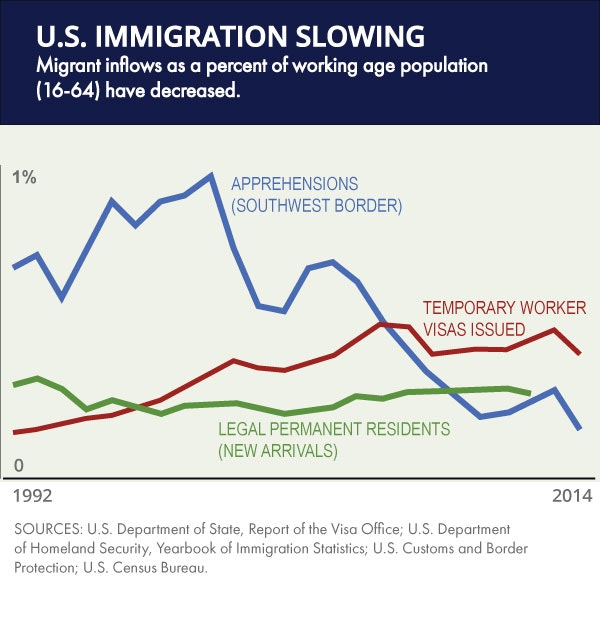Benefits of Immigration Outweigh the Costs
Contributions immigrants make are an economic boost we cannot overlook.

Immigration has emerged as a top issue in the presidential campaign. The timing is odd since immigration into the United States has slowed sharply.
Issuance of green cards, or permanent resident visas, to new arrivals has been largely flat since 2008, but dipped in 2013 to a six-year low. Illegal immigration is near record lows, with migrant apprehensions along the Southwest border at levels last seen in the 1970s. Temporary work-based visas have risen slightly in recent years but remain below their 2007 peak. Plotting visas and migrant apprehensions as a share of the nation’s working-age population, reinforces the point that immigration is slowing in both absolute and relative terms.
More on Immigration from the Bush Institute
A NATION BUILT BY IMMIGRANTS
America is strengthened by the contributions from immigrants. Read stories from American immigrants, debunk immigration myths, and read the Bush Institute policy recommendations.
ECONOMIC GROWTH INITIATIVE: IMMIGRATION
Pro-growth immigration reform can raise the pace of economic growth. Learn more about the Bush Institute’s work in immigration.
A lack of legislative action on immigration reform, rising border and interior enforcement of immigration laws, and the slow-growing U.S. economy have combined to stem the inflow of immigrant workers. The Mexican case is particularly striking, with demographers suggesting net inflows from Mexico were negative over the five-year period following the Great Recession. Economic stability in Mexico, and slower population growth, has dulled the “push factors” that generated mass emigration for four decades.
Against this backdrop of slowing immigration, it’s surprising that presidential politics are heating up around this issue.
Why we need immigration
Immigration fuels the economy. When immigrants enter the labor force, they increase the productive capacity of the economy and raise GDP. Their incomes rise, but so do those of natives. It’s a phenomenon dubbed the “immigration surplus,” and while a small share of additional GDP accrues to natives — typically 0.2 to 0.4 percent — it still amounts to $36 to $72 billion per year.
In addition to the immigration surplus, immigrants grease the wheels of the labor market by flowing into industries and areas where there is a relative need for workers — where bottlenecks or shortages might otherwise damp growth.
When immigrants enter the labor force, they increase the productive capacity of the economy and raise GDP. Their incomes rise, but so do those of natives. It’s a phenomenon dubbed the “immigration surplus.”
Immigrants are more likely to move than natives, and by relieving these bottlenecks to expansion, immigrants increase the speed limit of the economy. Growth accelerates as slack falls, a desirable scenario that follows from the improved allocation of resources in the economy.
There are many examples — nationally and regionally — of immigrants moving to where the jobs are. During and after World War II, Mexican immigrants were instrumental in alleviating shortages arising from the war effort. During the oil boom of the late 1970s and early 1980s, there was record migration to Texas. In the 1990s, it was the fast-growing South and Mountain West states that received immigrants, many for the first time.
In terms of occupations, immigrants flowed into high-tech jobs during the Internet boom and construction jobs during the 2000s housing boom.
Immigrants grease the wheels of the labor market by flowing into industries and areas where there is a relative need for workers — where bottlenecks or shortages might otherwise damp growth.
In addition, the rise in high-skilled immigration, a pronounced trend since the 1990s, has been linked to innovation, specifically to higher patenting rates among immigrants. Interestingly, greater innovation among immigrants appears to boost it among natives, too. Immigrants innovate more than natives because they are concentrated in STEM occupations where there is lots of R&D and entrepreneurial activity
Forty-four percent of medical scientists are foreign born, for example, as are 42 percent of computer software developers. Immigrant workers are also overrepresented among college professors, engineers, mathematicians, nurses, doctors and dentists, to name a few.
If immigration makes the economy larger, more efficient and productive, what’s the problem? Why do we, as a nation, strictly limit immigration?
 The Bush Insttitue hosted a naturalization ceremony honoring 20 new citizens from 12 countries, July 10, 2013. (Grant Miller / George W. Bush Presidential Center)
The Bush Insttitue hosted a naturalization ceremony honoring 20 new citizens from 12 countries, July 10, 2013. (Grant Miller / George W. Bush Presidential Center)
Yes, there are downsides
Immigration changes factor prices — it lowers the wages of competing workers, while raising the return to capital and the wages of complementary workers. In other words, the immigration surplus does not accrue equally to everyone. It goes primarily to the owners of capital, which includes business and land-owners and investors.
Complementary workers also benefit. The demand for these workers rises with more immigration. They may be construction supervisors, translators, pharmaceutical reps, or immigration lawyers. And consumers benefit from the lower prices of the goods and services that immigrants produce. But competing workers’ wages fall, at least in the initial transition period as the economy adjusts to the new labor inflow.
Research suggests that previous immigrants suffer more of the adverse wage effects than do natives. Prior immigrants are more like current immigrants.
Research also suggests any negative wage effects are concentrated among low-skilled and not high-skilled workers. Perhaps that is because high-skilled U.S.-born workers are complementary to immigrants to a greater extent than native low-skilled workers, who hold jobs that require less education and fewer language skills.
Overall, we are talking about a plus
Immigration is thus a positive but also disruptive change. There are lots of historical examples of positive yet disruptive economic change. The Industrial Revolution displaced millions of farm workers and resulted in the great urban migrations and the birth of mega-cities to which we now ascribe all kinds of positive attributes, including creativity and innovation and higher wages.
No great change is without some short-term cost. What is costly in the long-term is preventing market forces from funneling resources to their best use. The adjustment of wages and prices to the changing demand and supply in the economy are the levers of capitalism that direct resources to their best allocation.
Immigration has net benefits. The fact that it has some costs is not a reason to bar it, but rather to manage it. Mechanisms can be found to benefit from immigration’s gains while making up for the losses of some workers. International trade has similar effects, and workers adversely affected by trade are eligible for federal programs such as Trade Adjustment Assistance.
Immigration has net benefits. The fact that it has some costs is not a reason to bar it, but rather to manage it.
International migration is not much different than domestic migration, at least not in terms of economics. We Texans often celebrate Californians and others who move to Texas for the abundant jobs, lower house prices and lesser tax burden. In Texas, we have depended on this inflow of labor from other states to grow as fast as we have — about twice as fast as the nation since 1990. The state has benefited from the migration as have those who moved here.
Would wages have been higher without the inflow of labor? Perhaps temporarily. But wage inflation and skill shortages would have choked off investment and firms would have expanded elsewhere, in places where they could readily find more competitively priced resources.
Immigration is a net positive, even for those who don’t move, but the gains are not distributed equally. The next step for policymakers is to structure immigration reform to take advantage of immigration’s many benefits while mitigating the costs.
Immigration is a net positive, even for those who don’t move, but the gains are not distributed equally. The next step for policymakers is to structure immigration reform to take advantage of immigration’s many benefits while mitigating the costs.
The Catalyst believes that ideas matter. We aim to stimulate debate on the most important issues of the day, featuring a range of arguments that are constructive, high-minded, and share our core values of freedom, opportunity, accountability, and compassion. To that end, we seek out ideas that may challenge us, and the authors’ views presented here are their own; The Catalyst does not endorse any particular policy, politician, or party.

